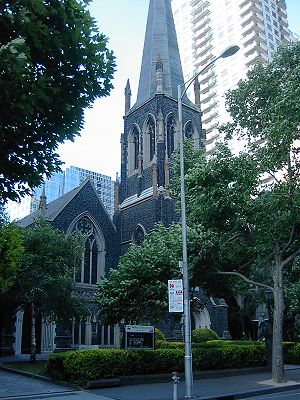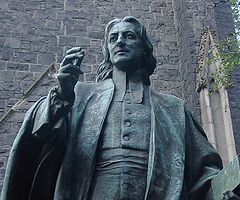
Wesley Church, Melbourne
Encyclopedia

Uniting Church in Australia
The Uniting Church in Australia was formed on 22 June 1977 when many congregations of the Methodist Church of Australasia, the Presbyterian Church of Australia and the Congregational Union of Australia came together under the Basis of Union....
in the centre of Melbourne
Melbourne
Melbourne is the capital and most populous city in the state of Victoria, and the second most populous city in Australia. The Melbourne City Centre is the hub of the greater metropolitan area and the Census statistical division—of which "Melbourne" is the common name. As of June 2009, the greater...
, in the State of Victoria
Victoria (Australia)
Victoria is the second most populous state in Australia. Geographically the smallest mainland state, Victoria is bordered by New South Wales, South Australia, and Tasmania on Boundary Islet to the north, west and south respectively....
, Australia
Australia
Australia , officially the Commonwealth of Australia, is a country in the Southern Hemisphere comprising the mainland of the Australian continent, the island of Tasmania, and numerous smaller islands in the Indian and Pacific Oceans. It is the world's sixth-largest country by total area...
.
Wesley Church was originally built as the central church of the Wesleyan movement in Victoria. It is named after John Wesley
John Wesley
John Wesley was a Church of England cleric and Christian theologian. Wesley is largely credited, along with his brother Charles Wesley, as founding the Methodist movement which began when he took to open-air preaching in a similar manner to George Whitefield...
(1703–1791), the founder of Methodism
Methodism
Methodism is a movement of Protestant Christianity represented by a number of denominations and organizations, claiming a total of approximately seventy million adherents worldwide. The movement traces its roots to John Wesley's evangelistic revival movement within Anglicanism. His younger brother...
. Today Wesley Church is the home of two Uniting Church congregations, the English-speaking Wesley Church, and the Chinese-speaking Gospel Hall.
In 1902, the Wesleyan Church in Australia combined with four other churches to form the Methodist Church of Australasia
Methodist Church of Australasia
The Methodist Church of Australasia was a Methodist denomination based in Australia.It ceased to exist in 1977 when most of its congregations joined with the many congregations of the Congregational Union of Australia and the Presbyterian Church of Australia to form the Uniting Church in...
. In 1977, the Methodist, Presbyterian and Congregational Churches further combined to form the Uniting Church
Uniting Church in Australia
The Uniting Church in Australia was formed on 22 June 1977 when many congregations of the Methodist Church of Australasia, the Presbyterian Church of Australia and the Congregational Union of Australia came together under the Basis of Union....
.
History
Wesleyans were part of the life of Melbourne from the beginning of European settlement. The first Christian worship service in Melbourne was led by Henry Reed, a businessman and Wesleyan lay preacher from Launceston, TasmaniaLaunceston, Tasmania
Launceston is a city in the north of the state of Tasmania, Australia at the junction of the North Esk and South Esk rivers where they become the Tamar River. Launceston is the second largest city in Tasmania after the state capital Hobart...
. The first service by an ordained Christian minister in Melbourne was led by Joseph Orton, Wesleyan Superintendent of Tasmania, on 24 April 1836. Joseph Orton had been a strong opponent of slavery in Jamaica, where he was imprisoned for his views. In Tasmania, he was an equally strong critic of mistreatment of aboriginal people.
A small chapel was built in 1838, and then replaced with a larger one in Collins Street
Collins Street, Melbourne
Collins Street is a major street in the Melbourne central business district and runs approximately east to west.It is notable as Melbourne's traditional main street and best known street, is often regarded as Australia's premier street, with some of the country's finest Victorian era buildings.The...
, able to seat 600 people, opened in June 1841. The organ imported for that church in 1842 is still in use in the present church.
The present Wesley Church, in Lonsdale Street
Lonsdale Street, Melbourne
Lonsdale Street is located in the centre of Melbourne, Victoria, Australia, part of the Hoddle Grid, it runs roughly east-west. Lonsdale Street's eastern end intersects with Spring Street while its western end intersects with Spencer Street. It is home to multiple office buildings, courts,...
was built in 1858. The Superintendent, Daniel Draper, strongly proposed a grand gothic design with high quality architecture. This design was criticised by many Wesleyans as too ornate, too Gothic and too Anglican for a Wesleyan Church. However, Draper's design prevailed. The foundation stone was laid on 2 December 1857, and the Church was opened on 26 August 1858.
This Church was the central congregation of the Wesleyan Church for Victoria, where the Conferences met, and where ministers were ordained. It was located in a poor part of Melbourne, and pioneered many initiatives in Community Service. In the 1880s, a team of Biblewomen were appointed to work with people experiencing serious poverty. One of these was Mrs Varcoe, who established Livingstone House, a home for homeless boys in Drummond St, Carlton.
In 1869, Wesley Church appointed Moy Ling to begin a Chinese-speaking congregation in Little Bourke Street. He named it the "Gospel Hall".
In 1893, during the acute depression which followed the bank crash of 1891, Alexander Edgar was appointed as minister, with an expectation that he would develop a city mission and be its first Superintendent. So Wesley became the base for the Central Methodist Mission, now called Wesley Mission Victoria, which grew into one of Melbourne's largest non-profit social welfare agencies. Its headquarters on this site adjoin the church. Edgar also began the "Pleasant Sunday Afternoon", where major speakers would speak about important public questions.
Irving Benson was Superintendent of the Mission for over 40 years, from 1926 to 1967. Under his leadership, the Pleasant Sunday Afternoon was broadcast on radio, widely across Victoria. The Central Methodist Mission took many new initiatives in that time, and he was knighted for his services to the community. However his conservative political views placed him increasingly at odds with the leadership of the Methodist Church.
His successor was Arthur Preston, Superintendent from 1968 to 1981. Under his leadership the Mission closed many of its institutions and replaced them by personal services. He was also a strong vocal opponent of the war in Vietnam.
In the 1970s, the Gospel Hall Chinese Church outgrew its building in Little Bourke St, and transferred its main service to Wesley Church.
Wesley Church became a Congregation of the Uniting Church in Australia in 1977, as did all Methodist Churches in Australia.
In 2000, both the Congregation and the Mission Board became polarised over proposals to establish a primary care health facility in the grounds, which would have included the option of supervised drug injection. As a result of this very public dispute, the Synod of Victoria separated the Mission from the Congregation in 2001. They now function as two separate bodies.
Since 2001, Wesley Congregation has become very cross-cultural, including members from many Asian cultures. This tendency has been encouraged by the previous minister, Jason Kioa, and the present minister, Douglas Miller.
Wesley Church's website describes its worship and theological style as "orthodox biblical teaching, classical reformed worship, and a cross-cultural lifestyle".
Architecture
Wesley Church was designed by Joseph ReedJoseph Reed (architect)
Joseph Reed , a Cornishman by birth, was probably the most influential Victorian era architect in Melbourne, Australia. He established a practice, Reed and Barnes in Melbourne in 1852. The practice now known as Bates Smart is one of the oldest continually operating in the world.Reed's buildings...
, who also designed the Melbourne Town Hall
Melbourne Town Hall
Melbourne Town Hall is the central municipal building of the City of Melbourne, Australia, in the State of Victoria. It is located on the northeast corner of Swanston and Collins Streets, in the central business district. It is the seat of the Local Government Area of the City of Melbourne...
, the Scots' Church
Scots' Church, Melbourne
The Scots' Church, a Presbyterian church in Melbourne, Australia, was the first Presbyterian Church to be built in the Port Phillip District . It is located in Collins Street and is a congregation of the Presbyterian Church of Australia...
and the Independent Church (now St. Michael’s in Collins St. The church is in the English Gothic style and takes the shape of a cross.
The church is 50.3 metres long from north to south and 23.5 metres across at the transepts. It has an octagonal spire rising 53.3 meters above ground level.
Wesley's organ was the first pipe organ in Melbourne. It was built in England, and arrived in Melbourne in 1842, being moved to the present church in 1858. It was largely rebuilt in 1957.
Inside the church are two paintings by the noted Australian painter Rupert Bunny
Rupert Bunny
Rupert Charles Wulsten Bunny was an Australian painter, born in St Kilda, Victoria. He achieved success and critical acclaim as an expatriate in fin-de-siècle Paris....
(1864–1947): "The Prodigal Son" (Luke 15:11-32) and "Abraham's Sacrifice" (Genesis 22:1-14), which Bunny gave to Wesley Church in 1934.

Paul Raphael Montford
Paul Raphael Montford was an English-born sculptor, active in Australia; winner of the gold medal of the Royal Society of British Sculptors in 1934.-Early life:...
in 1935.
The grounds contain other buildings, including the former School House, 1852, the old Parsonage, and Nicholas Hall, an art deco style hall which was a gift of the Nicholas family. Wesley House is the administrative centre of Wesley Mission. The Princess Mary Club, built to provide accommodation for young women starting study or a career in the city, was opened in 1926.
The grounds also contain an olive tree transplanted to the church grounds in 1875, but believed to be from a cutting brought to Melbourne from Jerusalem in 1839. This claim cannot be verified. If true, this tree could be the oldest imported tree in Victoria.
Sources
"A Century of Victorian Methodism", by C Irving Benson, Spectator Publishing Company, Melbourne, 1935."In Celebration of Faith: Stories and photos through 150 years at Wesley Church, Melbourne", edited Bill Gillard, 2008, published by Wesley Church Council to mark the 150th anniversary of the Church building.

